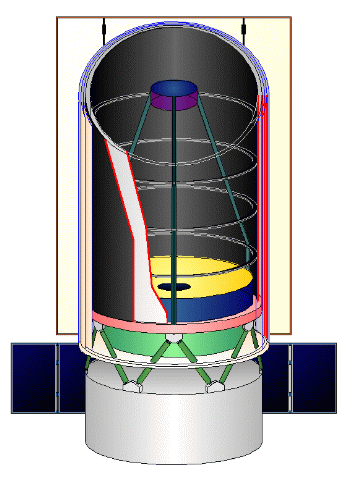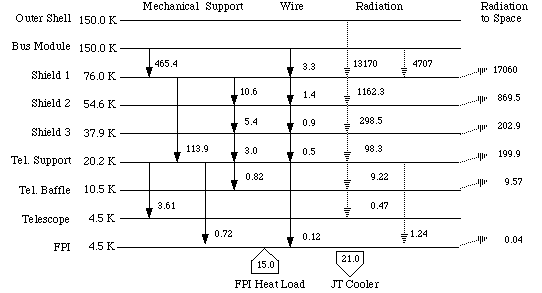Following the above discussions, we propose a new infrared astronomical mission; it is a ``warm-launch'' type mission to be put into the S-E L2 halo orbit. The ``warm-launch'' concept enables a satellite to have a large-aperture telescope, and the stable environment around the S-E L2 orbit allows the mission to make deep observations with long integration time. The combination of cryogenic coolers and the effective radiative cooling can keep the ``warm-launched'' telescope very cool in orbit, and makes the mission suitable for mid- to far-infrared observations.
We plan to use the new Japanese new H-IIA rocket to launch the satellite in to the S-E L2 halo orbit. We thus call this mission tentatively the ``HII/L2 mission''. Even the smallest type of the H-IIA series can launch a 2.5 t satellite into the S-E L2 orbit (Table 1).
The payload fairing of the H-IIA rocket
can accommodate a telescope with a 3.5 m primary mirror.
On the basis of
our experience with the 70 cm SiC mirror for the ASTRO-F/IRIS
telescope11, we estimate the mass of
a telescope system with a 3.5 m monolithic SiC mirror
to be about 1 t. This estimate is rather conservative,
since some active
support systems for the primary mirror
can reduce the mirror mass while keeping the image quality
good enough for ![]() 5
5 ![]() m.
We are also studying the feasibility of a deployable
mirror to increase the telescope aperture as large as 8 m.
In the following, we take a conventional 3.5 m mirror design
as a baseline (Table 2).
m.
We are also studying the feasibility of a deployable
mirror to increase the telescope aperture as large as 8 m.
In the following, we take a conventional 3.5 m mirror design
as a baseline (Table 2).

Figure 4 shows a conceptual design of the HII/L2 mission. Since this is a ``warm-launch'' type satellite, the telescope itself occupies a significant fraction of the total. This situation is completely different from that of conventional infrared astronomical satellites, in which not the telescope but the cryogenical system occupies a dominant fraction of the total volume.

Figure 5 shows heat flows of the model payload based on the conceptual design of Figure 4. We assume effective shielding of solar radiation so that we can cool the instrument effectively by radiation. We also assume a Joule-Thomson type cooler together with a two-stage Stirling cycle as in Figure 3. Figure 5 indicates that we can cool the whole telescope and the focal plane instruments down to 4.5 K by a modest cryogenic cooler system, such as shown in Figure 3, with the help of effective radiative cooling. The heat dissipation by the focal plane instruments at the 4.5 K stage can be as high as 15 mW. If lower temperature is required for some focal plane instruments, we plan to use another cooler such as a Joule-Thomson type cooler with 3He.
Table 2 summarizes the current specifications of the HII/L2 mission.
| Mirror Size (Baseline) | 3.5 m | |
|
| 4.5 K | |
|
| 300 K | |
| Core Wavelength | 5-200 | |
| Orbit | S-E L2 Halo | |
| Cooling | Radiative Cooling and | |
| Cryogenic Coolers. | ||
| No liquid helium | ||
| Mass Budget | ||
| Telescope | 1,100 kg | |
| Focal Plane Instrument | 100 kg | |
| Mission Structure | 400 kg | |
| Spacecraft | 600 kg | |
| Fuel | 300 kg | |
| Total | 2,500 kg | |
| Telemetry Rate | 3 G bytes day-1 | |
| Launching Vehicle | H-IIA rocket | |
| Launch Year | 2010 | |
Table 2: Summary of current specifications of the HII/L2 mission.